Yesterday’s liveblog can be found here. An archive of our liveblogs can be found here. For an overview and analysis of this developing story see our latest podcast.
Please help The Interpreter to continue providing this valuable information service by making a donation towards our costs.
View Ukraine: April, 2014 in a larger map
For links to individual updates click on the timestamps.
For the latest summary of evidence surrounding the shooting down of flight MH17 see our separate article: Evidence Review: Who Shot Down MH17?
Below we will be making regular updates so check back often.
SkyNews footage of Russian armor outside of Mariupol September 3.
Earlier today, we had a post about a claim from “Ruslan Ruslanchenko” that the Azov Battalion may have broken the ceasefire in Mariupol which drew some puzzled responses.
Translation: Commander of #Azov from besieged #Mariupol accuses the command of betrayal. Fascists are making accusations? Some sort of pun. #ATO #DPR.
This is a reference to a common portrayal of Azov as fascistic, which Western journalists have covered with fascination and RT.com has magnified as helpful war propaganda; indeed Azov uses Nazi-like symbols and is known for its ultranationalist ideology.
Whatever its extreme beliefs, Azov does not appear to have committed any atrocities, however; in fact, a good number of its idealistic recruits are getting killed in battle.
The volunteer battalions also believe they are being betrayed by the top brass — it’s a common theory that they are being sacrificed in the war and not given artillery back-up by regular troops. Conspiracies range from saying the zealous battalions are “projects of the Kremlin” (radicalization agents to discredit pro-Kiev forces) or sacrificed by a leadership that does not want to deal with their extremism after the war.
Translation: #Azov: All of our miserable equipment is destroyed. There are 200s [dead]. We worked under heavy fire, thanks to the spotter-betrayers.
The account @ru_988 is said to be run by Ruslan Ruslanchenko,
presumably a nom de guerre modeled after Semyon Semyonchenko, the
pseudonym for the commander of the Donbass Battalion and other members
of this battalion (it is meant to sound like a typically Ukrainian
name).
Ruslanchenko is the zampolit or political officer for the
battalion, a job that in the Soviet era meant responsibility for
political indoctrination and surveillance of troops, but today is
something more like communications and morale.
From other sources, we know that on September 4, near the towns on the road to Mariupol, the Russian troops shelled Ukrainian positions and destroyed one of the positions of Azov and the border service near Novoazovsk, as censor.net.ua reported. Generals who said they would send back-up with artillery did not come through, said the soldiers. At about 14:00, Russian forces attacked Bezymyonnoye.
Then on Friday morning, before the ceasefire began (it didn’t go into effect until 18:00 Kiev time), the Azov Battalion went on the counter-offensive, according to a story from apostrophe.com.ua posted at 11:29 am on September 5.
Ruslanchenko himself had some doubt as to what happened later then over the weekend during the supposed ceasefire, as he himself tweeted:
Translation: 12 and 13 checkpoints (C-side) #Mariupol are under shelling again. I don’t know if the Russkies are shelling themselves with Grads again or the morons from Azov — but it’s scary.
There is rivalry among battalions and tensions between the Russian-speaking and Ukrainian battalions; and tension between the volunteer brigades and the commanders.
This kind of gallows humor using a screenshot from a cooking show on TV summarizes what many of the men feel — the phrase for “cannon fodder” in Russian is literally “cannon meat,” and “kettle” means encirclement by armed forces.
Translation: Let’s throw meat in the kettle, like Valeriy Heletey [Defense Minister].
This kind of sardonic humor runs through the timeline and causes some people to question loyalties:
Viktor Tsoi, a famous rock musician, died in 1990. Dmitro Jarosz is
the head of the Azov Battalion, who is rumored to have been seriously
injured in battle.
But earlier, Ruslanchenko had written more seriously:
Translation: There really is trouble with comrade #Jarosz. I
can’t say everything, the Russkies are lying about his death, but his
condition is really serious. That’s why he’s not online.
Other tweets in the timeline aren’t exactly Kurt Vonnegut’s Slaughterhouse Five, but they are on the same bookshelf:
Translation: I’ve decided nonetheless to behave as a real
battle officer and shoot myself, but then I realized that my pistol was
stolen — and I had second thoughts. #ATO.
Translation: Ludmila Ludmilchenko, my war buddy, is a nurse and PPZh (marching field wife). Envy me, Cotton!
Ukrainians use a pejorative word for Russians, vata or vatnik, which means cotton or cotton jacket, of the style worn by Russian workers.
Translation: #Lugansk via youtube. I wouldn’t want to fight these wolves, these aren’t intellectual Odessa colorado beetles.
“Colorado beetles” is a pejorative term used by Ukrainians about Russians who wear the orange-and-black striped St. George ribbons adopted by nationalists in Russia and separatists in Ukraine.
Translation: When I pass by, I usually cry.
The statue is that of Stepan Bandera, the controversial historical figure who is a war hero for some Ukrainians, but documented as committing atrocities by historians. Russian propaganda calls all Ukrainians supporting Kiev
“Banderovites.”
Translation: Provocateurs disseminate information that while I was held captive I was recruited. This is a lie! Even so they don’t want to ask Parasyuk how he got out of #Ilovaisk.
In this and other outraged tweets, Ruslanchenko likely means Andrey Panasyuk, a young man who was captured by the Russian-backed separatists, interrogated, humiliated and filmed by a Russian journalist himself later killed, yet another polarizing story from the war.
Translation: A terrible night! If it is confirmed that the Russkies have taken #Volnovakha it means two of my volunteer buddies were killed at the checkpoint at the entrance.
The Donbass Battalion has indeed suffered enormous losses, both in battles and coming out of the “kettle” through the “humanitarian corridor” where they were said to be betrayed by Russian forces who ambushed them.
Earlier tweets in April on this account had many reports of separatist successes in towns throughout the Donbass, and it is not clear whether these are tweeted out of alarm or admiration.
Thus, a tour of Ruslanchenko’s timeline is a window into the complexities and contradictions and horrors of this war, and nothing can be said definitively about who betrayed whom, and the breaking of the ceasefire.
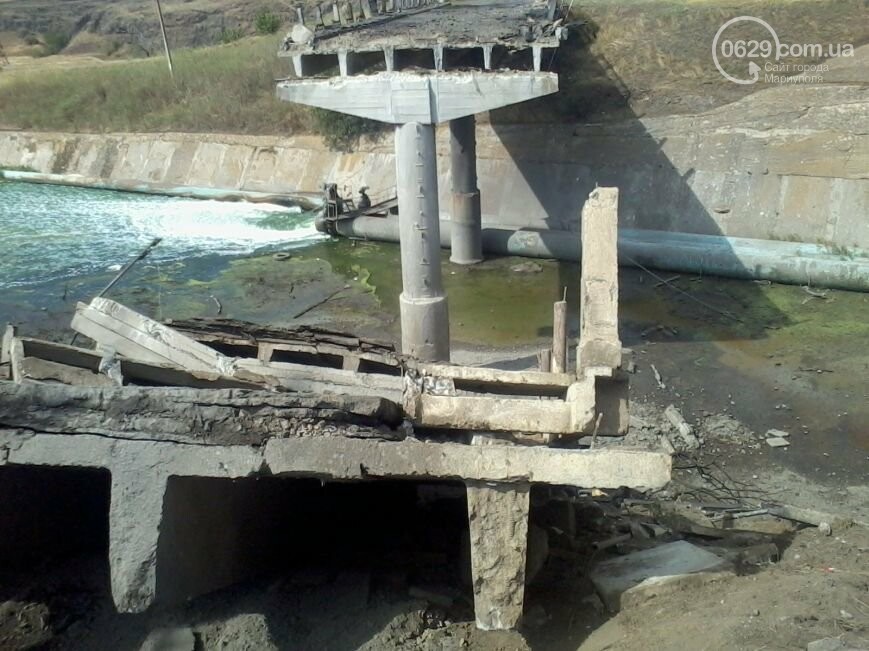
Local residents reported (translation by The Interpreter):
“Glass has blown out in many homes in Pavlopole, and the plaster has crumbled. The roof has been damaged,” eyewitnesses noted.
Passage to the villages of Chermalyk and Orlovskoye is closed, although the pedestrian road is not affected.
The European Union decided to impose new economic sanctions
on Russia last Friday, September 5 but said they could be suspended if
Moscow withdraws its troops from Ukraine and observes a ceasefire,
euractive.com reported.
Earlier UK Prime Minister David Cameron said that regardless if the ceasfire was enforced, sanctions against Russia would be enforced.
Reuters then reported this evening September 8 that the EU formally adopted the new package of sanctions, and they will enter into effect “in the next few days.”
The
EU sanctions would affect Russia’s top oil producers and pipeline
operators Rosneft, Transneft and Gazprom Neft, which would be put on the
list of Russian state-owned firms that will not be allowed to raise
capital or borrow on European markets, an EU diplomat said.The
sanctions, however, would not encompass the gas sector and in
particular state-owned Gazprom, the world’s biggest gas producer which
is also the biggest gas supplier to Europe.
EU President Herman Van Rompu commented on the dynamics of the sanction imposition, said Reuters:
“The
entry into force (of the new sanctions) through the publication in the
Official Journal will take place in the next few days. This will leave
time for an assessment of the implementation of the ceasefire agreement
and the peace plan. Depending on the situation on the ground, the EU
stands ready to review the agreed sanctions in whole or in part.”
Both
Russian and the insurgent movement it backs in Donbass have accused
Ukraine of breaking the ceasefire in Donetsk, but the Ukrainian
government points to shelling by Russian forces in Mariupol in violation
of the Minsk agreement.
We reported earlier today about a video uploaded of a ‘Novorossiya’ parade, where a T-72BM tank was clearly visible, recognizable by its distinctive reactive armour array on the turret. This tank has not been exported outside Russia and so cannot plausibly said to have been “stolen from the Ukrainian army.”
Now another new video of the parade has become available, which suggests that a Russian Federation military convoy was given to Russian-backed fighters. The video was uploaded to YouTube today, September 8, and is titled “Review of Kozitsin’s Cossacks.” This is a reference to Nikolai (Mykola) Kozitsin, a Cossack commander of the Russian-backed fighters. (Kozitsin previously figured in an intercept of conversations made by the Ukrainian Security Service (SBU) about the downing of the MH17.)
This video has not previously appeared in Google image search, its meta-data shows the date as September 8, 2014, and internally, the speaker narrating the parade can be heard repeatedly wishing people “Happy Holiday.” This is a reference to the Battle of Borodino of September 7, 1812, celebrated on September 8 in Russia as “Military Glory Day.”
The video has been geolocated to this position on Google Maps in Perevalsk, Lugank Region for The Interpreter by @djp3tros, the blogger at Ukraine@War.
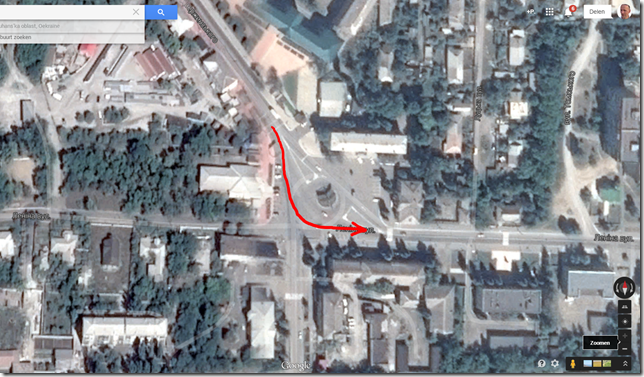
The building shown in the video behind the truck with the tarpaulin matches that of the Gornyak House of Culture on Panoramio.
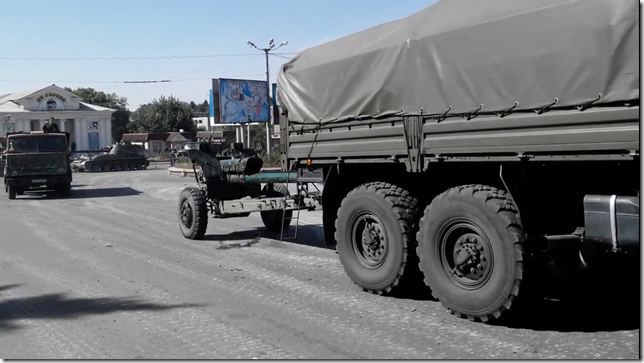

The vehicles show some of the bright green paint used in past videos of Russian convoys to blot out the identifying information on the vehicles.
The symbol at 0:28 in white paint may be the Russian paratroopers’ symbol.
A fighter in a Cossack-type hat can be seen at 1:46.
The martial music is playing on a loudspeaker on the scene, and the voice is praising the fighters as they go by, and crying “Glory to God!” and describing the weapons, i.e. mortars.
A decal on the truck at 2:15 looks like it was a Russian tricolor poorly scraped off. At 2:35 is a vehicle with the Russian flag and another unidentified red flag.
At 2:52, the speaker says the vehicle “was the Dillweeds’ but is now ours.” [Ukropy, the Russian word for “dillweeds” is a pejorative word for Ukrainians, —The Interpreter].
While the Russian-backed separatists claim they steal military equipment from the Ukrainian army rather than getting it from the Russian army, in some cases as with the T-72BM it can be shown the armor is not exported. In this case, the painting over of the insignia likely disguises the Russian origin.
Amnesty International has released a report which says that Russia is fueling the conflict in eastern Ukraine, a conflict in which war crimes have been committed by both sides:
“Our evidence shows that Russia is fueling the conflict, both through direct interference and by supporting the separatists in the East. Russia must stop the steady flow of weapons and other support to an insurgent force heavily implicated in gross human rights violations.”
The report includes satellite images which reportedly show Russian military vehicles and artillery engaged in battles, often resulting in indiscriminate shelling and civilian casualties.

The images show new artillery positions being established just inside the Ukrainian border between 13 and 29 August, including what appear to be 122-mm Howitzer D-30 artillery units in firing positions pointed toward the west. Two of the positions have a support vehicle and what looks like bunkers. On 29 August, six armoured amphibious vehicles (likely BRDM-2s) can be seen.
Another similar artillery position can be seen in a field northeast of the first, also within Ukrainian territory. Imagery from 26 August 2014 shows six relatively advanced self-propelled howitzers (likely 2S19 Msta-S 152-mm) in firing positions facing southwest at Ukrainian army locations.
Between 26 and 29 August 2014 the artillery has been moved into a west facing firing position still within Ukraine. On August 29 the imagery shows what look like numerous military vehicles in the area along the tree line and in the neighboring field.
“These satellite images, coupled with reports of Russian troops captured inside Ukraine and eyewitness accounts of Russian troops and military vehicles rolling across the border, leave no doubt that this is now an international armed conflict,” said Shetty.
Despite the ceasefire, the Ukrainian government is reporting that it sees more signs of Russian armor, troops, and heavy weaponry crossing the border. RFE/RL reports:
Ukraine has leveled new allegations about Russian troop movements in its restive east, one day after President Petro Poroshenko promised to draft a new cease-fire plan following talks with Russian President Vladimir Putin.
Military spokesman Andriy Lysenko said today that Russian soldiers and armor had crossed into Ukraine and entered the town of Amvrosiyivka, 60 kilometers southeast of Donetsk — a stronghold of pro-Russian rebels.
Ukraine also said a large convoy of tanks and heavy weaponry from Russia was traveling toward Telmanove, 80 kilometers south of Donetsk.
Ukrainska Pravda reports that Andrei Lysenko, the spokesman for the Ukrainian National Security and Defence Council (SNBO), has told reporters at his daily briefing in Kiev today that members of the Ukrainian National Guard have been encircled near Slavyanoserbsk, a town to the north-west of Lugansk.
According to Lysenko, the troops were encircled yesterday by Russian or Russian-backed forces.
He said (translated by The Interpreter):
“Yesterday, near Slavyanoserbsk, the Russians have set up their own roadblock directly in front of a National Guard checkpoint. After this, our security officers were asked to leave their checkpoint, under the threat that a Russian military convoy would pass right through and, in the event of any returning fire, everyone would be killed.”
Lysenko said that observers from the OSCE met with the separatist fighters, “who agreed to maintain distance between the parties.”
“However, immediately after the departure of the OSCE representatives, the checkpoint was surrounded on three sides 4 vehicles covered in concealing green paint: 4 T-72 tanks, 2 BMDs, 2 BMPs, 4 BTRs and around 70 soldiers,” said Lysenko.
“Now our servicemen are maintaining their defence of the checkpoint and have no intention to leave their positions. At this time there is no active confrontation,” he stated.
The SNBO released a video which shows both one of the tanks apparently manoeuvring near the Ukrainian positions (a T-72) and Ukrainian soldiers speaking to OSCE monitors. The OSCE monitors tell them that they cannot report seeing a Russian tank (the Ukrainians insist it is Russian as the T-72 is not in use in active use by Ukrainian forces).
The ‘Sea Breeze 2014’ exercise begins today in the Black Sea. The NATO naval exercise, organised by the USA and Ukraine will run until September 10.
A NATO Allied Command Operations statement says:
The event will test maritime interdiction operations, communications, search and rescue, force protection and navigation. The United States and Ukraine are organizing the annual exercise ‘Sea Breeze’ which will run from 8-10 September 2014. This year’s participants include Ukraine, Georgia, Romania, Turkey, and the United States. NATO is represented by the Canadian frigate HMCS Toronto, the Spanish frigate SPS Almirante Juan de Borbon and the Romanian frigate ROS Regele Ferdinand. The three ships are under the command of Standing NATO Maritime Group Two Rear Admiral Brad Williamson. SNMG2 is part of NATO’s four Standing Maritime Forces.
In response to Russia’s actions in Ukraine, NATO has increased its air patrols over the Baltic countries and increased naval patrols in the Baltic Sea and the eastern Mediterranean. The NATO Summit in Wales last week (4-5 September) agreed to form a new rapid reaction force and to further step up exercises in Eastern Europe to enhance the collective defence of Allies.

The Spanish frigate SPS Almirante Juan de Borbon passing through the Black Sea straits escorted by a Turkish Coastguard vessel. Photo courtesy of: MARCOM Public Affairs Office.
Meanwhile on land, the ‘Rapid Trident 2014’ exercise, involving Ukraine, the USA, the UK, Germany, Georgia, Azerbaijan, Spain, Bulgaria, Canada, Lithuania, Latvia, Poland, Norway and Romania, is due to be held in western Ukraine from September 15-26.
Here is a tweet from September 6 that we missed at the time:
Translation: Those morons from Azov decided to play at war and started firing, but we have to face the consequences for the violation of the ceasefire and defend Mariupol.
The tweeter is Ruslan Ruslanchenko the (presumably pseudonymous) zampolit (deputy political officer, here likely meaning responsible for handling communications and morale) for the volunteer Donbass battalion.
The account seems legitimate and there is evidence in other tweets of tension between the Azov battalion, who carry insignia associated with neo-nazi movements, and the other volunteer groups.
Translation: PRAYER OF THE UKRAINIAN NATIONALIST [link] with the help of Youtube these [expletives] from Azov brave only on video, have screwed us over.
He also reported accusations that members of the Azov battalions had been presenting themselves, while masked, as members of a new Mariupol volunteer brigade, collecting funds from unwitting residents.
Translations by The Interpreter.
The following video shows a celebratory parade held yesterday by separatists in the town of Perevalsk in the Lugansk region.
Alongside the display of manpower and armour, one particularly noteworthy appearance, is that of what looks to us to be a T-72BM, visible at 5:39 and 6:36.
Here are some screenshots of the tank in question:
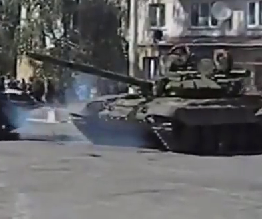
.
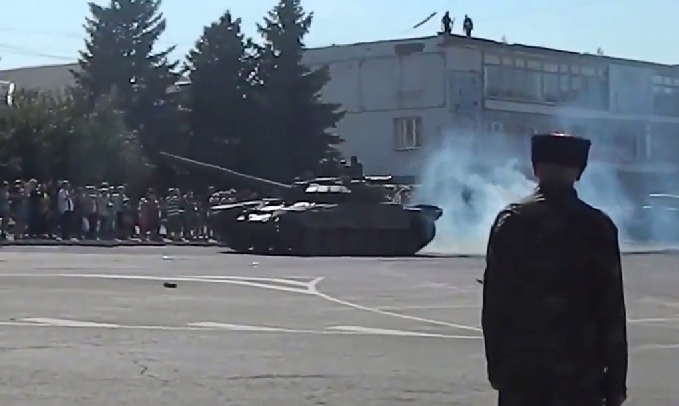
Compare this tank with one identified by analysts from the International Institute of Strategic Studies as a Russian T-72BM:

As Joseph Dempsey of the IISS told the BBC, while discussing the vehicle above, the BM variant of the T-72, recognisable by its distinctive reactive armour array on the turret, has not been exported outside Russia. This is yet more, clear evidence of Russian military intervention in Ukraine.
LB.ua reports (translated by The Interpreter):
Today, at around 12:50 [9:50 GMT], shelling began in Debaltsevo, in the Donetsk region. This was reported to LB.ua by servicemen at a nearby ATO camp.
According to them, the firing came from Grads and D-30 howitzers. There is no news yet on casualties.
In addition, Ukrainian artillery positions close to Debaltsevo were shelled.
UPDATE 14:50 [11:50]: ATO forces in Nizhnaya Krynka outside Makeyevka are being shelled with Grads. Loud volleys are heard in Makeyevka.
Recall that yesterday, Ukrainian military positions outside Makeyevka were shelled with artillery.
Despite some reports that member states were pushing for further sanctions to be held following the announcement of the ceasefire in Minsk on Friday, it is being reported that the EU will go ahead and impose further sanctions on Russia:
A European Commission spokeswoman said the new sanctions package targeting Russian firms and officials “is due to be formally adopted by member states through a written procedure later today, so the procedure is ongoing”.
“It will then be published in the official journal of the EU, which should happen in the course of tomorrow at the latest as plans currently stand,” she said.
Publication in the journal puts the sanctions into effect.
Russia has threatened to close its airspace to European carriers in the event of further sanctions. Speaking to Vedomosti, the Russian prime minister, Dmitry Medvedev, said that:
“We proceed from the basis that we have friendly relations with our partners, and because of this, the skies above Russia are open to overflight. But if we are restricted, we have to respond. If Western carriers have to fly outside of our airspace then it could lead to the bankruptcy of many aviation companies, which are already surviving on the brink.”
The EU sanctions are reported to target several key Russian energy companies:
The port city of Mariupol, on the coast of the Azov Sea, which has been under regular bombardment from Russian and Russian-backed forces to the east, has, reportedly, been quiet since last night.
Ukrainian President Petro Poroshenko is due to arrive shortly in Mariupol (Mariupol news site 0629 reported an expected arrival time of 13:00).
